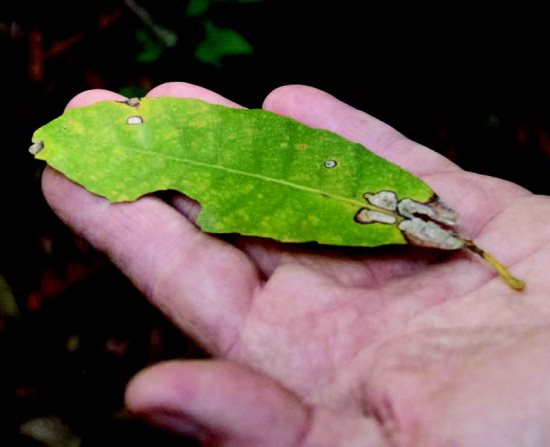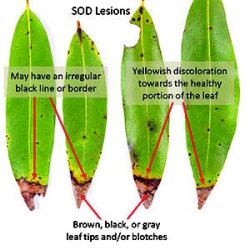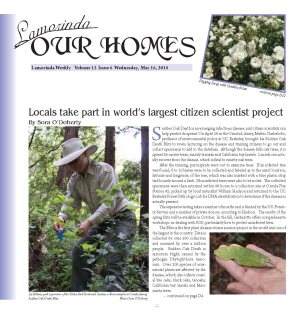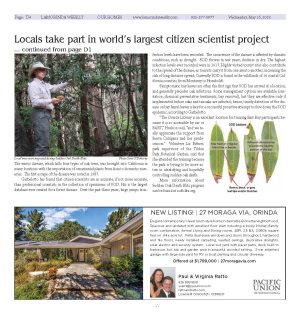| | Published May 16th, 2018
| Locals take part in world's largest citizen scientist project
| | | By Sora O'Doherty |  | | Liz Bittner, park supervisor of the Tilden Park Botanical Garden, collects samples in Orinda during Sudden Oak Death Blitz. Photos Sora O'Doherty |
Sudden Oak Death is an emerging infectious disease, and citizen scientists can help predict its spread. On April 28 in the Orinda Library, Matteo Garbelotto, professor of environmental policy at UC Berkeley, brought his Sudden Oak Death Blitz to town, lecturing on the disease and training citizens to go out and collect specimens to add to the database. Although the disease kills oak trees, it is spread by carrier trees, mainly tanoaks and California bay laurels. Laurels can actually recover from the disease, which is fatal to nearby oak trees.
 After the training, participants went out to examine trees. If an infected tree was found, 6 to 10 leaves were to be collected and labeled as to the exact location, latitude and longitude, of the tree, which was also marked with a blue plastic strip tied loosely around a limb. Non-infected trees were also to be noted. The collected specimens were then returned within 48 hours to a collection site at Orinda Fire Station 45, picked up by local naturalist William Hudson and returned to the UC Berkeley Forest Pathology Lab for DNA identification to determine if the disease is actually present.
After the training, participants went out to examine trees. If an infected tree was found, 6 to 10 leaves were to be collected and labeled as to the exact location, latitude and longitude, of the tree, which was also marked with a blue plastic strip tied loosely around a limb. Non-infected trees were also to be noted. The collected specimens were then returned within 48 hours to a collection site at Orinda Fire Station 45, picked up by local naturalist William Hudson and returned to the UC Berkeley Forest Pathology Lab for DNA identification to determine if the disease is actually present.
 The expensive testing takes a number of months and is funded by the U.S. Forestry Service and a number of private donors, according to Hudson. The results of the spring blitz will be available in October. In the fall, Garbelotto offers comprehensive workshops on dealing with SOD, particularly how to protect uninfected trees.
The expensive testing takes a number of months and is funded by the U.S. Forestry Service and a number of private donors, according to Hudson. The results of the spring blitz will be available in October. In the fall, Garbelotto offers comprehensive workshops on dealing with SOD, particularly how to protect uninfected trees.
 The Blitz is the first plant disease citizen science project in the world and one of the largest in the country. Data is collected by over 500 collectors and accessed by over a million people. Sudden Oak Death is ramorum blight, caused by the pathogen Phytophthora ramorum. Over 200 species of ornamental plants are affected by the disease, which also infects coastal live oaks, black oaks, tanoaks, California bay laurels and Manzanita trees. The exotic disease, which kills four types of oak trees, was brought into California in many locations with the importation of ornamental plants from Asia to domestic nurseries. The first escape of the disease was noted in 1987.
The Blitz is the first plant disease citizen science project in the world and one of the largest in the country. Data is collected by over 500 collectors and accessed by over a million people. Sudden Oak Death is ramorum blight, caused by the pathogen Phytophthora ramorum. Over 200 species of ornamental plants are affected by the disease, which also infects coastal live oaks, black oaks, tanoaks, California bay laurels and Manzanita trees. The exotic disease, which kills four types of oak trees, was brought into California in many locations with the importation of ornamental plants from Asia to domestic nurseries. The first escape of the disease was noted in 1987.
 Garbelotto has found that citizen scientists are as accurate, if not more accurate, than professional scientists in the collection of specimens of SOD. His is the largest database ever created for a forest disease. Over the past three years, huge jumps in infection levels have been recorded. The occurrence of the disease is affected by climatic conditions, such as drought. SOD thrives in wet years, declines in dry. The highest infection levels ever recorded were in 2017. Highly visited tourist sites also contribute to the spread of the disease, as tourists carry it from one area to another, increasing the risk of long distance spread. Currently SOD is found in the wildlands of 14 coastal California counties, from Monterey to Humboldt.
Garbelotto has found that citizen scientists are as accurate, if not more accurate, than professional scientists in the collection of specimens of SOD. His is the largest database ever created for a forest disease. Over the past three years, huge jumps in infection levels have been recorded. The occurrence of the disease is affected by climatic conditions, such as drought. SOD thrives in wet years, declines in dry. The highest infection levels ever recorded were in 2017. Highly visited tourist sites also contribute to the spread of the disease, as tourists carry it from one area to another, increasing the risk of long distance spread. Currently SOD is found in the wildlands of 14 coastal California counties, from Monterey to Humboldt.
 Symptomatic bay leaves are often the first sign that SOD has arrived at a location, and generally precedes oak infections. Some management options are available (sanitation, chemical preventative treatments, bay removal), but they are effective only if implemented before oaks and tanoaks are infected; hence, timely detection of the disease on bay laurel leaves is key for a successful proactive attempt to slow down the SOD epidemic, according to Garbelotto.
Symptomatic bay leaves are often the first sign that SOD has arrived at a location, and generally precedes oak infections. Some management options are available (sanitation, chemical preventative treatments, bay removal), but they are effective only if implemented before oaks and tanoaks are infected; hence, timely detection of the disease on bay laurel leaves is key for a successful proactive attempt to slow down the SOD epidemic, according to Garbelotto.
 "The Orinda Library is an excellent location for training East Bay participants because it is so accessible by car or BART," Hudson said, "and we really appreciate the support from Sierra Campana and her predecessors." Volunteer Liz Bittner, park supervisor of the Tilden Park Botanical Garden, said that she attended the training because the park is trying to be more active in identifying and hopefully controlling sudden oak death.
"The Orinda Library is an excellent location for training East Bay participants because it is so accessible by car or BART," Hudson said, "and we really appreciate the support from Sierra Campana and her predecessors." Volunteer Liz Bittner, park supervisor of the Tilden Park Botanical Garden, said that she attended the training because the park is trying to be more active in identifying and hopefully controlling sudden oak death.
 More information about Sudden Oak Death Blitz program can be found at sodblitz.org.
More information about Sudden Oak Death Blitz program can be found at sodblitz.org.

|
 | | |  | | Local trees were inspected during Sudden Oak Death Blitz. Photo Sora O'Doherty |  | | | | | | | | | |







